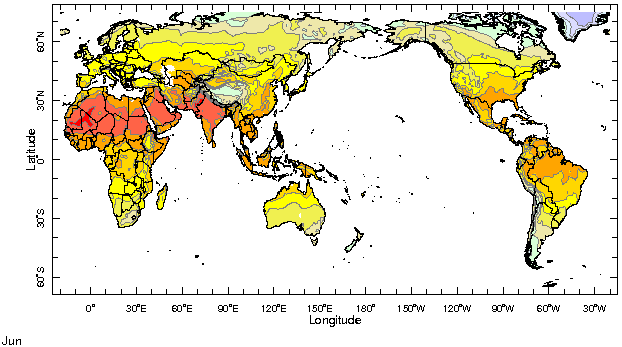|
IRI Climate Digest
July 2002
June Global Climate Summary
Climatological Background
In June, the sun's maximum northward location is achieved at 23.6 degrees north. Surface heating of the continents has initiated summer monsoonal systems or northern hemisphere warm season rains. In the Southern Hemisphere winter is setting in with fewer daylight hours and cooler temperatures. The southern parts of South Africa, Australia and South America are now in the path of mid latitude storm tracks.
Monthly Mean Temperature (1961-1990), data from the Climate Research
Unit, University of East Anglia


Monthly Mean Precipitation (1961-1990), data from the Climate Research
Unit, University of East Anglia


Temperatures
Warm conditions continued in West Africa and Brazil, while warm anomalies developed or strengthened over China and parts of North America. Western Europe and eastern Russia remained warmer than normal, as cool conditions continued over parts of central Asia.
Europe and Asia: The temperature anomaly pattern over Eurasia in June was similar to that in May, with warmer than normal temperatures over much of western Europe and central and eastern Russia, and slightly cooler than normal conditions over Kazakhstan and parts of central Asia. Warm temperatures also extended into central and southeastern China.
North America: The colder than normal temperatures that had persisted over much of Canada since April have disappeared, replaced by near- or slightly above-normal conditions. Very warm temperatures were found in the U. S. Southwest, northern plains, and Rocky Mountains.
South America: Above-normal temperatures have persisted over Brazil, especially the south, for several months. Well-below normal temperatures were found in southern Chile and Argentina in June.
Africa: Unusually warm temperatures continued from May over much of West Africa, and the interior of southern Africa.
Australia: Most of the continent experienced near-normal temperatures in June, although anomalously warm conditions were found in Tasmania.
Temperature Difference from the 1961-1990 mean, with data
from NCEP Climate Prediction Center, CAMS.


Precipitation
Dry conditions intensified or continued in Central America, parts of western and eastern Africa, Australia, eastern Europe, and the central United States. Dry anomalies developed in western Europe, and the moist conditions that had persisted for several months in southern Brazil, Uruguay, and northern Argentina were reduced in extent and intensity. Above-normal rainfall continued in northern South America. Much of China experienced above-average precipitation, and heavy monsoon rains occurred in western India.
Africa: In June, a band of below-normal rainfall extended from the Guinea Coast into parts of central and eastern Africa, including the Great Lakes, southern Sudan, and western Ethiopia.
South America: Heavier than normal precipitation continued in northern South America. Southern Brazil, Uruguay, and northern Argentina, received a respite from the above-normal rainfall that had persisted for several months.
North America: Except for the Florida peninsula and scattered locations in the northern U. S. and Canada, much of the continent experienced below-normal precipitation in June.
Central America: Dry conditions prevailed throughout Central America in June.
East and Southeast Asia: Many areas of China received above-normal precipitation in June, while much of Southeast Asia, Malaysia, and the western islands of Indonesia experienced precipitation deficits. Above-normal rainfall was found in the southern Philippines, and areas of eastern Indonesia.
Southern Asia: Parts of western India received particularly heavy monsoon rainfall in June.
Australia and New Zealand: Below-normal precipitation continued in southern Australia and northern New Zealand.
Europe: Except for a band of above-normal precipitation from the northern British Isles to Scandinavia, most of Europe experienced precipitation deficits in June.
Precipitation Difference from 1961-1990 mean, with data
from NCEP Climate Prediction Center, CAMS-OPI.


Oceanic Conditions
Tropical Pacific: The warm anomaly in the equatorial Pacific continued to develop towards a more coherent, basin-wide El Niņo pattern. Please see the latest IRI ENSO Update for a detailed summary and outlook.
Tropical Atlantic: The anomalies off of western Africa north of the equator continued to be colder than average, while the warm anomalies along the west coast of Southern Africa diminished. Warm anomalies off the southeastern coast of South America developed further.
Indian Ocean: Surface temperatures continued to develop warmer than average in the central and eastern basin, while the cooler waters diminished somewhat off the coast of Africa, but strengthened in the subtropical south.
Mid latitudes: Warmer than average surface waters continued to dominate the midlatitudes around 30 degrees north and south of the equator, with modest cold anomalies poleward and eastward.
Monthly Sea Surface Temperature Difference from the 1950-1979 mean,
with data from the Environmental Modeling Center, NCEP/NOAA.


Contents |
Special |
Impacts |
Climate |
Forecast
|

